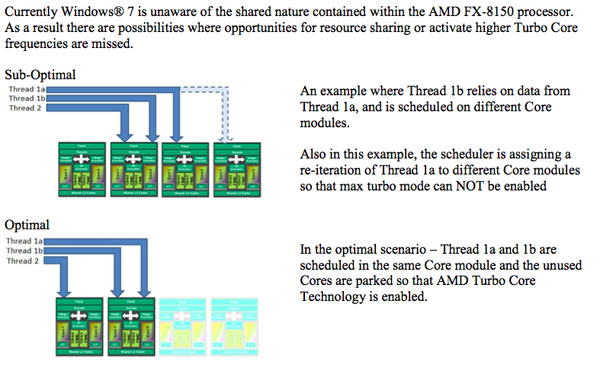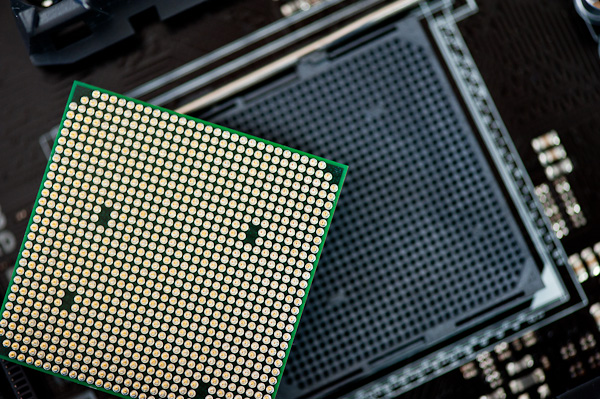The Bulldozer Review: AMD FX-8150 Tested
by Anand Lal Shimpi on October 12, 2011 1:27 AM ESTFinal Words
In many cases, AMD's FX-8150 is able to close the gap between the Phenom II X6 and Intel's Core i5 2500K. Given the right workload, Bulldozer is actually able to hang with Intel's fastest Sandy Bridge parts. We finally have a high-end AMD CPU with power gating as well as a very functional Turbo Core mode. Unfortunately the same complaints we've had about AMD's processors over the past few years still apply here today: in lightly threaded scenarios, Bulldozer simply does not perform. To make matters worse, in some heavily threaded applications the improvement over the previous generation Phenom II X6 simply isn't enough to justify an upgrade for existing AM3+ platform owners. AMD has released a part that is generally more competitive than its predecessor, but not consistently so. AMD also makes you choose between good single or good multithreaded performance, a tradeoff that we honestly shouldn't have to make in the era of power gating and turbo cores.
Bulldozer is an interesting architecture for sure, but I'm not sure it's quite ready for prime time. AMD clearly needed higher clocks to really make Bulldozer shine and for whatever reason it was unable to attain that. With Piledriver due out next year, boasting at least 10-15% performance gains at the core level it seems to me that AMD plans to aggressively address the shortcomings of this architecture. My only concern is whether or not a 15% improvement at the core level will be enough to close some of the gaps we've seen here today. Single threaded performance is my biggest concern, and compared to Sandy Bridge there's a good 40-50% advantage the i5 2500K enjoys over the FX-8150. My hope is that future derivatives of the FX processor (perhaps based on Piledriver) will boast much more aggressive Turbo Core frequencies, which would do wonders at eating into that advantage.

AMD also shared with us that Windows 7 isn't really all that optimized for Bulldozer. Given AMD's unique multi-core module architecture, the OS scheduler needs to know when to place threads on a single module (with shared caches) vs. on separate modules with dedicated caches. Windows 7's scheduler isn't aware of Bulldozer's architecture and as a result sort of places threads wherever it sees fit, regardless of optimal placement. Windows 8 is expected to correct this, however given the short lead time on Bulldozer reviews we weren't able to do much experimenting with Windows 8 performance on the platform. There's also the fact that Windows 8 isn't expected out until the end of next year, at which point we'll likely see an upgraded successor to Bulldozer.

So what do you do if you're buying today? If you have an existing high-end Phenom II system, particularly an X4 970 or above or an X6 of any sort, I honestly don't see much of a reason to upgrade. You're likely better off waiting for the next (and final) iteration of the AM3+ lineup if you want to stick with your current platform. If you're considering buying new, I feel like the 2500K is a better overall part. You get more predictable performance across the board regardless of application type or workload mix, and you do get features like Quick Sync. In many ways, where Bulldozer is a clear win is where AMD has always done well: heavily threaded applications. If you're predominantly running well threaded workloads, Bulldozer will typically give you performance somewhere around or above Intel's 2500K.
I was hoping for Bulldozer to address AMD's weakness rather than continue to just focus on its strengths. I suspect this architecture will do quite well in the server space, but for client computing we may have to wait a bit longer for a more competitive part from AMD. The true culprit for Bulldozer's lackluster single-threaded performance is difficult to track down. The easy answer would seem to be clock speed. We've heard of issues at Global Foundries and perhaps Bulldozer is the latest victim. If AMD's clock targets were 30% higher than Phenom II, it simply didn't make them with the FX-8150. I've heard future derivatives will focus more on increasing IPC indepedent of process technology and clock speed, but if you asked me what was the one limit to success I would say clock speed. As a secondary factor, AMD appeared to make some tradeoffs to maintain a reasonable die size at 32nm. Even then Bulldozer can hardly be considered svelte. I suspect as AMD is able to transition to smaller transistor geometries, it will be able to address some of Bulldozer's physical shortcomings.
The good news is AMD has a very aggressive roadmap ahead of itself; here's hoping it will be able to execute against it. We all need AMD to succeed. We've seen what happens without a strong AMD as a competitor. We get processors that are artificially limited and severe restrictions on overclocking, particularly at the value end of the segment. We're denied choice simply because there's no other alternative. I don't believe Bulldozer is a strong enough alternative to force Intel back into an ultra competitive mode, but we absolutely need it to be that. I have faith that AMD can pull it off, but there's still a lot of progress that needs to be made. AMD can't simply rely on its GPU architecture superiority to sell APUs; it needs to ramp on the x86 side as well—more specifically, AMD needs better single threaded performance. Bulldozer didn't deliver that, and I'm worried that Piledriver alone won't be enough. But if AMD can stick to a yearly cadence and execute well with each iteration, there's hope. It's no longer a question of whether AMD will return to the days of the Athlon 64, it simply must. Otherwise you can kiss choice goodbye.











430 Comments
View All Comments
Iketh - Wednesday, October 12, 2011 - link
AMD Exec a year ago: "We about ready to release BD?"AMD Engineer: "Soon. At 4ghz, we're actually slower per thread and using double the power than Phenom at 3.4ghz, but we'll get there..."
AMD Exec: /gquit
lyeoh - Wednesday, October 12, 2011 - link
Bulldozer reminds me of the P4/Prescott for some reason ;).High clock, high watts, but not enough performance.
Might be faster in parallelizable tasks but most people with such tasks would just buy more computers and build large clusters.
Iketh - Wednesday, October 12, 2011 - link
The processors are popping up on Newegg now... the 8120 for $220 and 6100 for $190vol7ron - Wednesday, October 12, 2011 - link
Sigh... I made the mistake in buying a Prescott. Not to mention I bought an "E" batch, which ran even hotter and weren't as overclockable.actionjksn - Wednesday, October 12, 2011 - link
Yeah I had one of those hot potato's too. Back then we thought Intel was finished.just4U - Thursday, October 13, 2011 - link
ckryan, you stated you were blown away by the 2500K yes? It's odd you know.. I've owned a PII 920, PII 1055, PII 955 (tested lots of lowbie $60-80 parts from AMD to) .. also used a i7 920, i7 955 i5 2500k i7 2600k (my most recent one) and .. I am not blown away by any of them..Last time I was blown away by a cpu was the Q6600..(before that the A64 3200+) since then other cpu's have been better but not so much so that I'd say that it was night and day differences.
CeriseCogburn - Wednesday, March 21, 2012 - link
Ok that was some enormously skilled twisting and spinning. BD is an epic failure, period. I can't envision anyone with any needs, need, or combo thereof choosing it.\It's so bad amd lied about it's transistor count.
Forget it, it's an epic fail and never anything more.
jiffylube1024 - Wednesday, October 12, 2011 - link
Ugh, BD is quite the disappointment. The power consumption is absolutely through the roof -- unacceptable for 32nm, really!With that said, I am very intrigued in the FX-4100 4-core 3.6GHz part. This should be the replacement for the Athlon II 2-4 core series, and I'm very interested to see how it does vs ~3 GHz Athlon II X2's, X3's and X4's.
yankeeDDL - Wednesday, October 12, 2011 - link
Wow ...I'm blown away.
I have been waiting for BD's reviews and benchmarks for months. I have waited for BD for my new rig.
I have used AMD for the past 8 years and I am ... was convinced that it always offered, by far, the best price/performance ratio for entry-level, mid range PCs.
I am a still a big fan of AMD ... but I have to stand corrected. BD is a POS. Longer pipelines? Didn't they learn anything from Pentium 3/4 debacle?
A Phenom II X6 is almost always better than BD, even in power consumption. Come on: if BD had come out shortly after the Phenom I could see it as an incremental improvement, a new baseline to build upon. But it took AMD years to come out with BD ... and this is the result? Disappointing.
I mean, betting everything on higher clock frequencies? At 4GHz? It's no wonder that Intel's IPC improvements are crunching BD: IPC is all about doing more with the same power, clock speed is all about throwing more power to do the same faster ...
Boy. This ruined my day.
yankeeDDL - Wednesday, October 12, 2011 - link
By the way, no matter how AMD slices it, I see the FX-8* as a 4-core CPU. A glorified ohene, but still a 4-core.If I was AMD, I would have considered a fair goal to obliterate the i5-2500 performance with the new FX-8 family, instead it comes short most of the times.
What were they thinking?